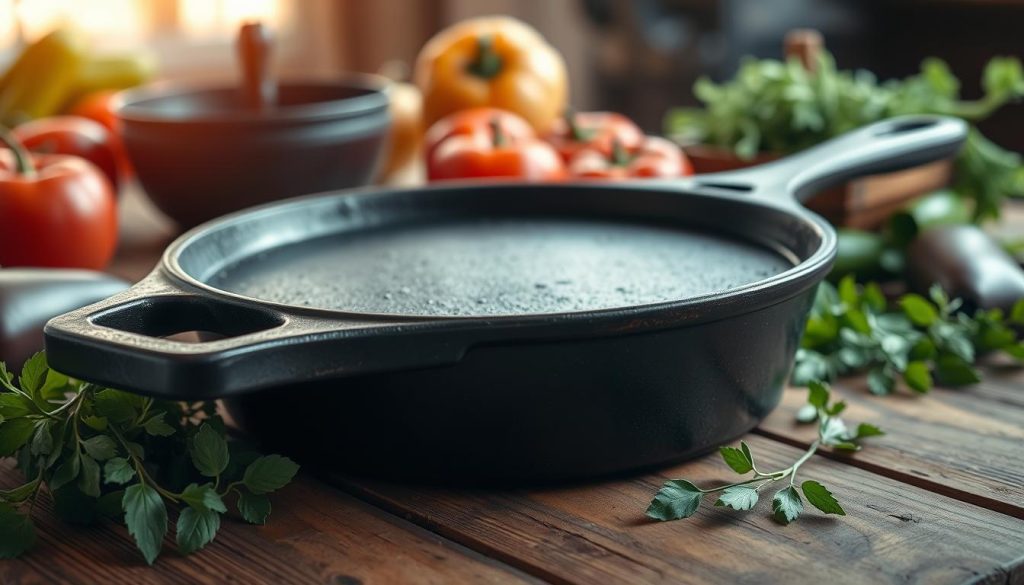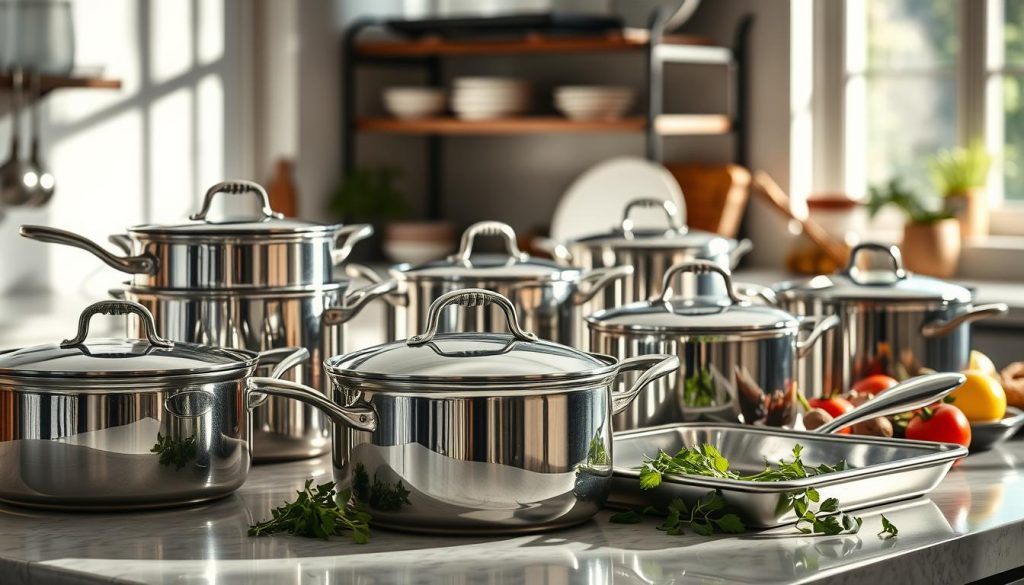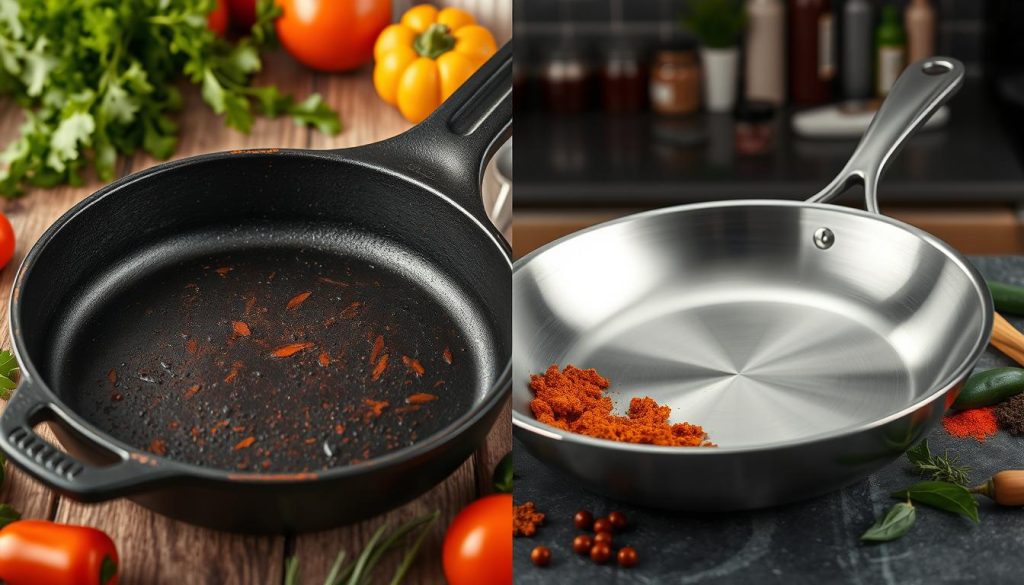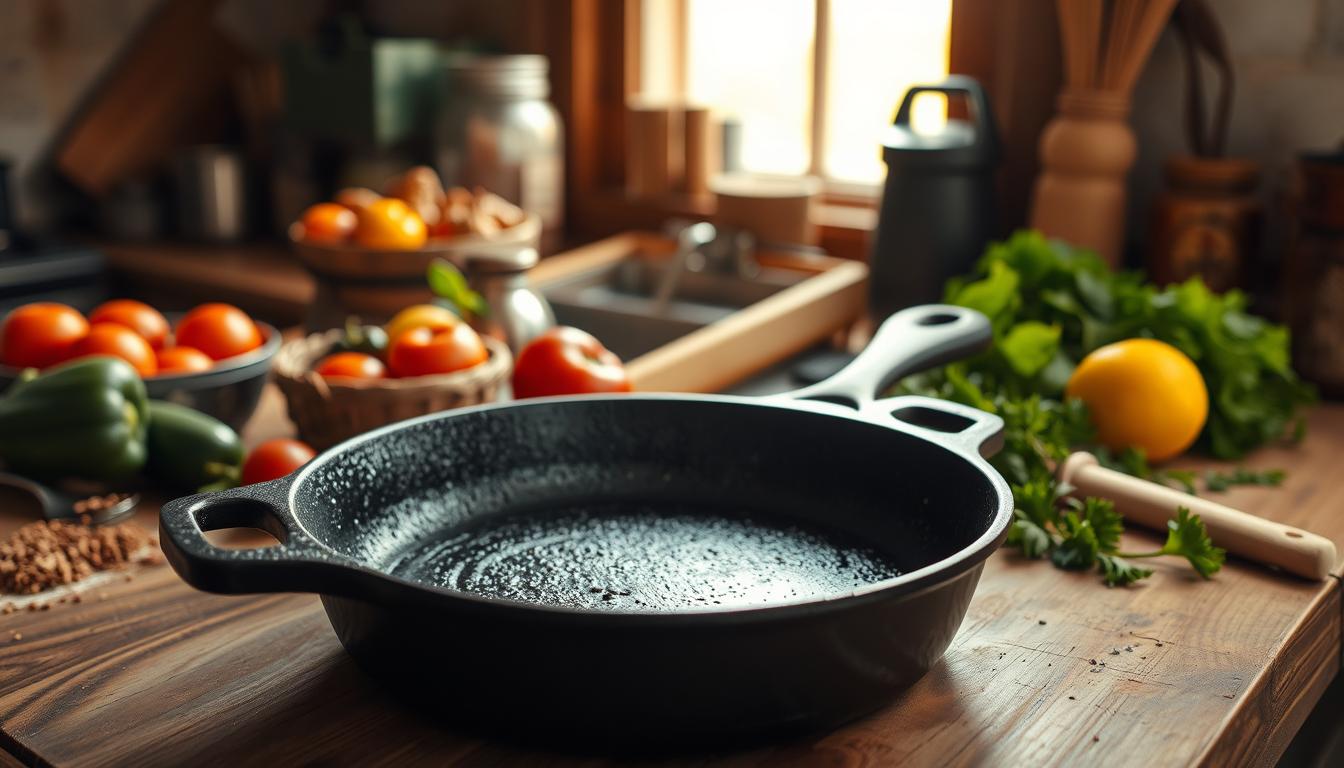Choosing the right cookware is important for me. I look for the best for searing. Cast iron and stainless steel have their own good and bad points.
I’ve tried many cookware types. Cast iron and stainless steel are among the most popular. But, which one fits my cooking style best? Let’s look at their pros and cons together.
Whether it’s a big meal or a simple dish, I need reliable cookware. Stainless steel is durable and easy to use. Cast iron is great for keeping heat and is versatile. I think about what I want in my cooking. Do I need something for searing, or is maintenance more important?
A Personal Journey into Cookware Choices
My cookware journey started with a cast iron skillet passed down to me. Its durability and versatility caught my eye. I used it for everything from searing steaks to baking cornbread. Cooking with cast iron has become a key part of my kitchen.
I learned the importance of seasoning cast iron to keep it non-stick. This skill has been crucial in maintaining my cookware.
My Initial Cookware Experience
I soon found out that cast iron needs regular care. This includes cleaning and seasoning to avoid rust and keep it non-stick. I learned a lot about cast iron skillet care to keep mine in top shape.
Discovering the Benefits and Drawbacks
Exploring other cookware, I saw stainless steel’s benefits like easy cleaning and scratch resistance. Yet, cooking with cast iron offers a unique experience that’s hard to find elsewhere.
My experiences with cast iron and stainless steel taught me a lot. Choosing the right cookware and maintaining it well is key. This ensures it lasts for many years.
Understanding Cast Iron Cookware

Cast iron cookware has been a favorite in kitchens for centuries. It’s loved for its ability to keep heat and distribute it well. This makes it perfect for searing, frying, and baking.
It’s especially great for getting a perfect crust on foods like skillet-roasted chicken and pan-seared steak.
Seasoning is key when it comes to cast iron skillet care. It makes the surface non-stick and prevents rust. To keep it in good shape, clean it well after each use and apply a thin layer of oil.
Cast iron cookware is not just durable and versatile. It also has health benefits. Cooking acidic foods in it can increase your iron intake.
The Unique Properties of Cast Iron
Cast iron cookware has many advantages:
- Even heat distribution
- Durability and longevity
- Versatility in cooking methods
- Health benefits from increased iron intake
My Favorite Cast Iron Dishes
My top dishes to cook with cast iron are skillet-roasted chicken, pan-seared steak, and baked cornbread. These dishes highlight the cookware’s versatility and ability to achieve a perfect crust and texture.
Seasoning and Maintenance Tips
To keep cast iron cookware in top shape, follow these tips. Clean it after each use, apply a thin layer of oil, and avoid harsh chemicals or abrasive cleaners.
Discovering Stainless Steel Cookware

I’ve discovered that stainless steel cookware is perfect for both home cooks and professional chefs. It’s easy to use, durable, and won’t scratch easily. I’ve used stainless steel pots and pans for a while. They’re great because they don’t react with food, making them perfect for many dishes.
Some of the advantages of using stainless steel cookware include:
- Easy to clean and maintain
- Non-reactive properties, which prevent the transfer of flavors and odors
- Durable and resistant to scratches and corrosion
- Versatile and can be used for a variety of cooking techniques, including stir-fries and sautés
Advantages of Using Stainless Steel
Compared to cast iron, stainless steel has its own benefits. It’s easy to clean and maintain. Stainless steel also heats evenly, which is great for cooking delicate dishes. Adding stainless steel cookware to your kitchen is a smart choice.
Comparing Heat Distribution
Stainless steel cookware wins when it comes to heat distribution. It heats up fast and evenly, perfect for many dishes. Stainless steel pots and pans are ideal for stir-fries and sautés because they heat quickly and evenly.
Comparing Durability and Longevity

When looking at cast iron vs stainless steel cooking, durability and longevity are key. Cast iron is known for its toughness, lasting through high heat and rough use. Yet, it needs regular care to avoid rust and keep its non-stick surface.
Stainless steel, on the other hand, is durable and resistant to corrosion. It can handle scratches and dents well. But, it might show heat discoloration and could need replacing more often. Here’s a quick comparison:
- Cast iron can last decades with the right care, while stainless steel might need replacing every 5-10 years.
- Cast iron handles high temperatures better, but stainless steel can be more vulnerable to heat damage.
- Stainless steel is easier to clean and maintain than cast iron, which needs seasoning and upkeep.
The choice between cast iron and stainless steel depends on your needs. Cast iron is great for those who want something durable and can handle high heat. Stainless steel is better for those who want something easy to clean and maintain.
| Cookware Type | Durability | Longevity | Maintenance |
|---|---|---|---|
| Cast Iron | High | Decades | Regular seasoning and maintenance |
| Stainless Steel | Medium | 5-10 years | Easier to clean and maintain |
Health and Safety Considerations
When cooking, health and safety are key. Both cast iron and stainless steel have their good and bad sides. Cast iron is great for increasing iron intake, especially for those with iron deficiency. It does this by adding iron to food, especially in acidic dishes.
Non-reactive cooking is also vital. Stainless steel is perfect for cooking delicate foods because it doesn’t react with them. Cast iron, when seasoned right, can also be non-reactive. But, it needs proper care to stay that way.
Non-Reactive Cooking with Stainless Steel
Stainless steel is great for non-reactive cooking. It’s perfect for those who care about avoiding chemical reactions in their food. This makes it a top choice for health-conscious cooks.
Cast Iron’s Iron Benefits for Health
Cast iron is not just tough and versatile; it’s also good for your health. It helps increase iron intake, which is great for people with iron deficiency anemia. Cooking with cast iron can naturally boost your iron levels.
My Perspective on Cookware Safety
Cookware safety is often ignored but it’s very important for our health. Keeping cookware clean, handling it right, and storing it properly are key. By picking the right cookware and following safety tips, we can cook healthy and tasty meals.
Cookware safety is a big deal for anyone who cooks at home. Knowing the health perks of cast iron, non-reactive cooking, and safety tips helps us make better choices. This way, we can keep our cooking space healthy and safe.
Versatility in Cooking Techniques
Having the right tools is key in cooking. Both cast iron and stainless steel cookware open up many cooking possibilities. Cast iron is great for hearty dishes like skillet-roasted veggies and seared meats. Stainless steel shines at high-heat cooking, perfect for stir-fries and sautés.
Knowing the strengths of each material is crucial. Cast iron is ideal for dishes needing a nice crust, like pan-seared steak or roasted veggies. Stainless steel is better for quick temperature changes, like in stir-fries or sautés.
The Range of Dishes for Cast Iron
Some of my favorite cast iron recipes include:
- Skillet-roasted chicken with vegetables
- Pan-seared steak with a crispy crust
- Hearty stews and braises
Stainless Steel for High-Temperature Cooking
Stainless steel is perfect for high-temperature cooking, such as:
- Stir-fries with quick-cooked vegetables and meat
- Sautés with delicate fish or seafood
- Seared scallops or shrimp
By understanding each material’s strengths, I’ve explored many cooking techniques. This has allowed me to make a variety of tasty dishes with both cast iron and stainless steel cookware.
Making the Right Choice for You
Choosing between cast iron and stainless steel cookware depends on several factors. The best cookware for searing varies based on your cooking style. Cast iron excels at high-heat searing and even heating. Stainless steel is better for stir-frying and high-temperature cooking.
It’s important to match your cookware to your cooking needs. Cast iron is great for dishes that need even heating, like searing steaks or baking bread. Stainless steel is better for quick-cooking methods like sautéing or deglazing.
My advice is to pick cookware that fits your cooking style and preferences. Whether you choose cast iron’s durability or stainless steel’s versatility, the right cookware can greatly enhance your cooking. Trust your instincts and experiment to find the perfect fit for your kitchen.

